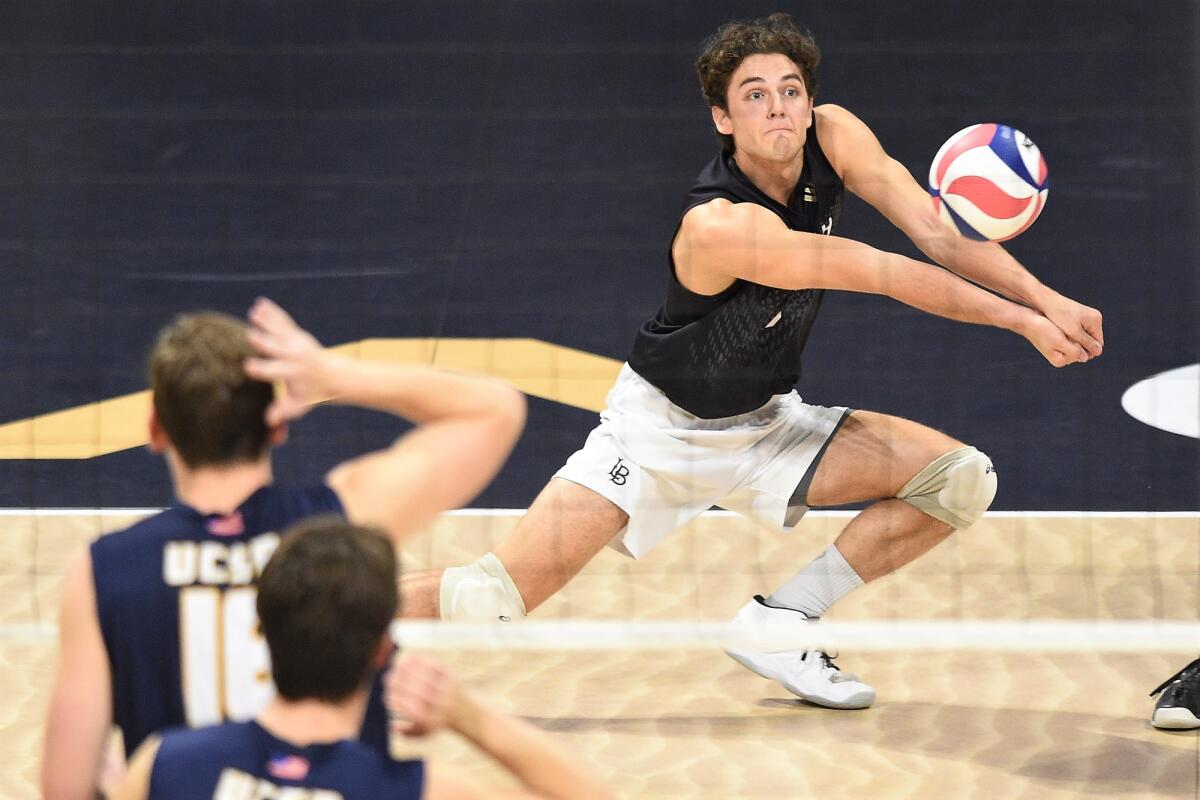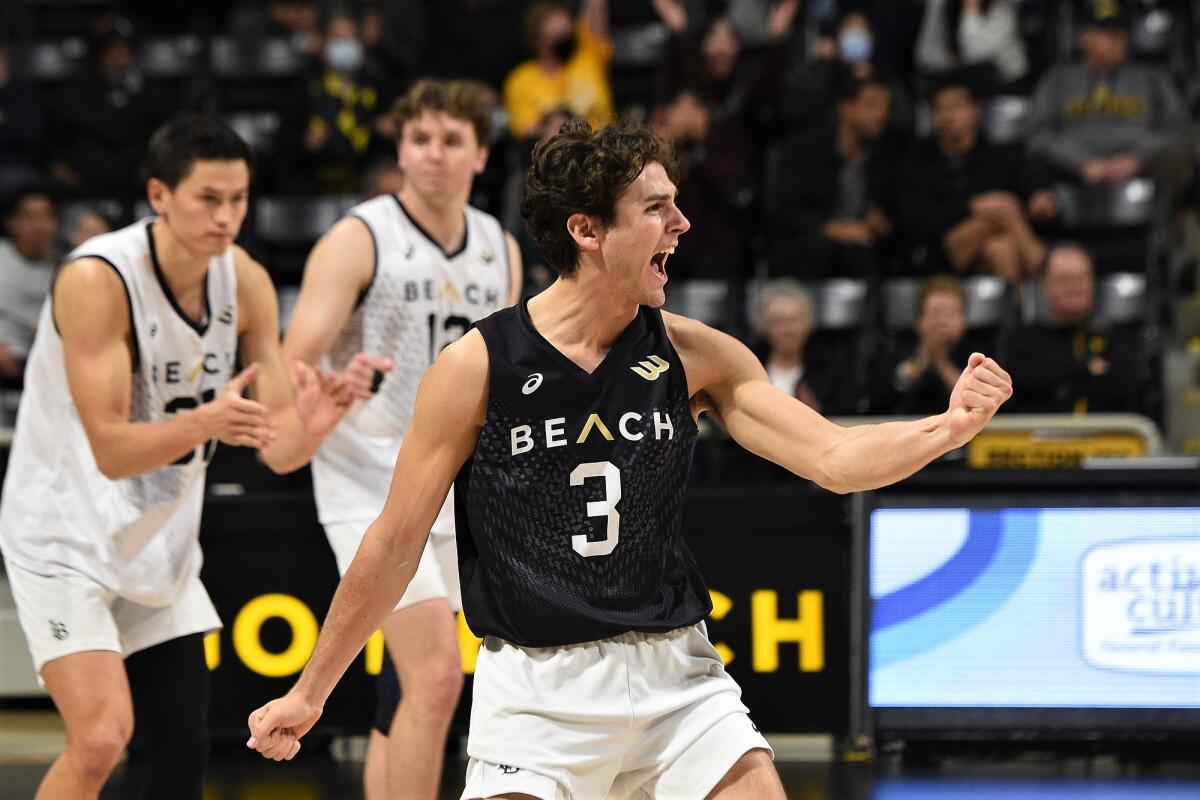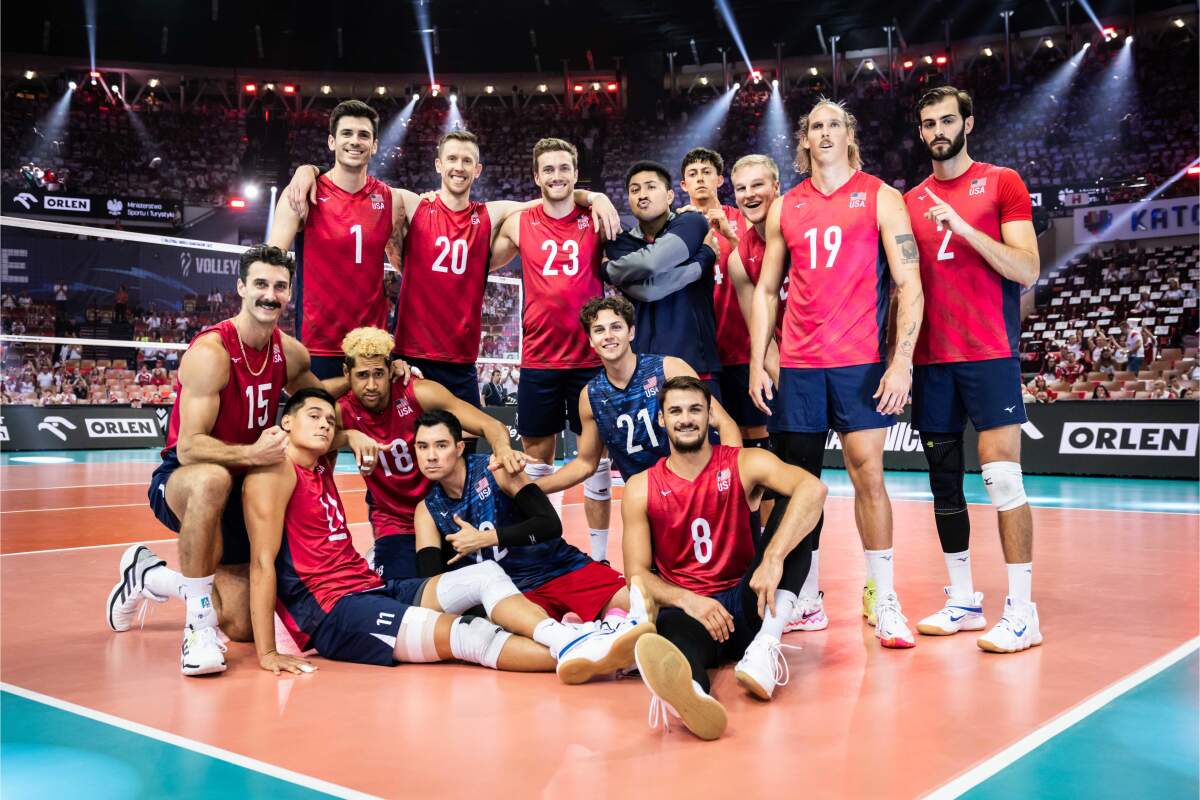Dig this: Long Beach State’s Mason Briggs could be next big thing at libero

- Share via
He’s often the shortest player on the court. He wears a different color jersey than his teammates. He almost never scores points. Yet fans still want to be like Mason Briggs.
After matches this year, fans regularly approached the Long Beach State libero to tell him that they want to play the same position as him. He’s still surprised by the message.
“I’m a libero and I play collegiately,” Briggs said, “but I’ve never really heard that.”
The Long Beach State redshirt junior is helping make liberos cool again while boosting the Beach men’s volleyball team (20-4) to its sixth NCAA tournament appearance in the last seven seasons. No. 4 Long Beach State begins the hunt for its fourth national title on Tuesday in Fairfax, Va., at 2 p.m. PDT against No. 7 Grand Canyon. The winner advances to Thursday’s semifinal against No. 1 UCLA.
While high-flying hitters dominate volleyball headlines, the player wearing the different jersey color quietly makes those plays happen. Liberos must stand in front of a thunderous hit or serve to send an accurate pass to the setter that gets the team’s offense in rhythm.
“What [people] don’t realize a lot of times, during a match when it’s very comfortable and they’re giving lots of credit to how good the hitters are, is what actually happened between that libero-setter connection,” Long Beach State coach Alan Knipe said. “When you’ve had the seasons that we’ve had last year and this year, it speaks volumes to what Mason’s been able to do.”

After earning first-team All-American status last year and winning Off the Block’s Erik Shoji and Steve Shondell Awards as the nation’s best libero and passer, respectively, Briggs ranks fifth nationally in digs with 2.36 per set. The Beach, which advanced to the NCAA championship game last year, leads the seven-team NCAA tournament field in digs per set with 8.76 and ranks eighth nationally in opponent hitting percentage at .204.
Briggs didn’t choose this position. His height chose the position.
The 6-foot former Bishop Alemany High star also played setter and outside hitter in high school, but knew he wouldn’t grow to be a towering 6-foot-5 attacker at the next level. So when it came to playing for his club and youth national teams, Briggs happily took his spot in the back row. Many young players approaching him after games are coming to the same realization that they could transition from an undersized outside hitter to a libero to prolong their volleyball careers.
Liberos are defensive and passing specialists who help organize the team’s serve receive, typically set if the team’s setter is forced to play the ball on first contact and cover on blocks. Liberos can substitute freely out of the back row.
But they can’t attack the ball in front of the 10-foot line. They can’t block. And in men’s college volleyball, they can’t serve.
The limited job description shouldn’t be mistaken for an easy role. Hitters can serve or block their way out of a rut, but liberos have nowhere to hide.

“There’s not a lot of ways out of failure,” Briggs said. “You gotta have the ability to forget quickly. You have a bad pass, OK, I’m going to pass the ball again, there’s no other way to make up for that.”
The youngest of a volleyball-obsessed family, Briggs learned the art of libero early. Oldest brother Trevor won national titles with Long Beach State in 2018 and 2019 as a libero. Middle brother Tanner played at Vanguard. Their parents played and coached, and Briggs’ older cousins went to UCLA. Competitive games in the neighborhood cul-de-sac against family and neighbors molded Briggs’ ability to move forward quickly after successes and shortcomings.
Watching Trevor participate in the U.S. high performance camps as a teenager inspired Briggs to hatch his biggest volleyball goal of competing in the Olympics. He was 10. It’s not a dream, Briggs is careful to specify. A dream is a far-flung hope. This goal has an outline, a process and a plan.
So far, Briggs’ plan is right on track.
Last summer, Briggs helped the United States to bronze medals at the NORCECA Pan American Cup Final Six tournament and the XV Pan American Cup. He won individual awards as each event’s best receiver and the best digger, respectively.
After the rosters for both tournaments were primarily composed of top college players, Briggs proved he belonged among the nation’s very best by making the cut for the FIVB World Championships. Then 21, he was the youngest libero to make the U.S. roster for a senior world championship.
The team’s only college player didn’t see the court behind two-time Olympian Erik Shoji, but with the Paris Olympics looming and a hometown Summer Games for Briggs in 2028, U.S. and UCLA coach John Speraw is keeping an eye on the promising 22-year-old Long Beach State prospect.

“[Shoji] has been maybe the best that’s ever played for the United States, but he’s also getting to the point in his career where I think they’ll probably be some conversations about whether he’ll continue to L.A.,” Speraw said. “If so, who the next person will be is up for debate, it’ll be a competition and I think Mason is in that mix. … He has the potential though, 100%.”
Knipe, who coached the United States during the 2012 Olympics, knew “from Day 1” that Briggs had Olympic potential. It was more than his physical skillset; it was his dedication to studying film to scout opposing servers, ability to align his teammates to receive a serve and, most importantly, the influence he had on his teammates.
“He makes people play harder because he’s on the court,” Knipe said. “He plays for his teammates, which makes them want to play hard for him. … That’s a sign of a great player.”
Hyping his teammates after they connect on a vicious kill or rocket an ace over the net feels like catharsis for Briggs. He has no other way to vent his emotions on the court, especially because his role always depends on the actions of others when he reads a hitter’s attack or responds to a serve.
Briggs speaks longingly about the hope of getting to control a point for himself just once. He jokes about sneaking back to the service line during a match one of these days. There’s no knowing what Briggs can do next.
More to Read
Go beyond the scoreboard
Get the latest on L.A.'s teams in the daily Sports Report newsletter.
You may occasionally receive promotional content from the Los Angeles Times.










